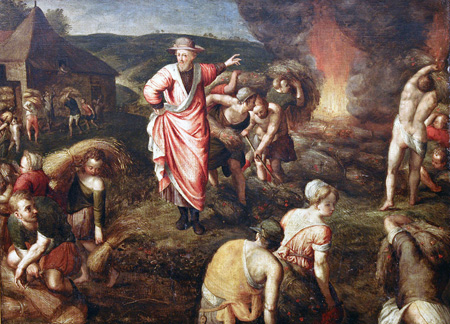There are only thirty or so major parables that Jesus gave in the New Testament, although he used a lot of figures and symbols in his teachings. But no explanations that he gave at the time to the disciples were handed down – except for two. Jesus explains the very first parable, the famous Parable of the Sower, and this one. It is known as the Parable of the Tares, (or Weeds). Unlike most of the parables, this one is found solely in Matthew.
A bit of background: “tares” are likely Lolium temulentum, typically known as darnel, ryegrass, or cockle. This is a weed that closely resembles wheat in its early phases of growth before the ears develop. Not only that, it can be poisonous, or a host to ergot, which could lead to hallucinations, convulsions, or death. Darnel could sabotage a farmer’s whole harvest, make its consumers sick, and endanger his livelihood if sown secretly in his fields.
The context is the same as with the Parable of the Sower: Jesus is in the boat teaching because of the size of the crowd. Here’s the parable:
He set another parable before them, saying, “The Kingdom of Heaven is like a man who sowed good seed in his field, but while people slept, his enemy came and sowed darnel weeds also among the wheat, and went away. But when the blade sprang up and produced grain, then the darnel weeds appeared also. The servants of the householder came and said to him, ‘Sir, didn’t you sow good seed in your field? Where did these darnel weeds come from?’
“He said to them, ‘An enemy has done this.’
“The servants asked him, ‘Do you want us to go and gather them up?’
“But he said, ‘No, lest perhaps while you gather up the darnel weeds, you root up the wheat with them. Let both grow together until the harvest, and in the harvest time I will tell the reapers, “First, gather up the darnel weeds, and bind them in bundles to burn them; but gather the wheat into my barn.”’” (Matt. 13:24-30)
This is followed by another two short parables. After all that comes Jesus’ interpretation to the boys at the end of the day, but only for the story about the weeds:
Then Jesus sent the multitudes away, and went into the house. His disciples came to him, saying, “Explain to us the parable of the darnel weeds of the field.”
He answered them, “He who sows the good seed is the Son of Man, the field is the world, the good seeds are the children of the Kingdom, and the darnel weeds are the children of the evil one. The enemy who sowed them is the devil. The harvest is the end of the age, and the reapers are angels. As therefore the darnel weeds are gathered up and burned with fire; so will it be at the end of this age. The Son of Man will send out his angels, and they will gather out of his Kingdom all things that cause stumbling and those who do iniquity, and will cast them into the furnace of fire. There will be weeping and gnashing of teeth. Then the righteous will shine like the sun in the Kingdom of their Father. He who has ears to hear, let him hear.” (Matt. 13:32-43)
Using the same Term Substitution Method employed before naturally closely matches Jesus’ spiritual interpretation. His terms are underlined, those from The Word Unveiled derived from the Fathers are [in brackets] and modern ones (in parentheses).
He set another parable before them, saying, “The presence of God is in the Son of Man who (replenishes) the people of the Kingdom in the world, but while [all reasonable beings] [were lost in illusion], [the Devil] came and (repopulated) people of the evil one also among the children of the kingdom, and went away. But when the [simple believers] sprang up and produced [faith], then the people of the evil one appeared also. The [disciples] of the Son of Man came and said to him, ‘Sir, didn’t you preach to people of the Kingdom in the world? Where did these evildoers come from?’
“He said to them, ‘[The Devil] has done this.’
“The [disciples] asked him, ‘Do you want us to go and gather them up?’
“But he said, ‘No, lest perhaps while you gather up the people of the evil one, you root up the people of the Kingdom with them. Let both grow together until the end of this age, and in the end of this age time I will tell the angels, “First, gather up the evildoers, and (restrict) them in (groups) to destroy them; but gather the (people of God) into (Heaven).”’”
In both these parables – undoubtedly because Jesus himself supplied most of the meanings – the interpretations used in countless sermons are often about the same. Yet put this way the message seems a lot more direct than most preaching. It now carries the punch that 2,000 years of popular preaching has softened.
It should also be noted that some of the meanings of terms changed between the Parable of the Sower and this one. In the first, the sower is any teacher of the Gospel, in the second, he is the Son of Man. Likewise, while the seed in the first is the Good News; but in the second, it is the believers. Sowing meant preaching in the first, in this, it seems to relate to its idiomatic use of “replenish or repopulate.”
Likewise, while the Sower was basically concerned with the morality of belief, that of the Weeds is eschatological — concerned with the End of the World. Others will have similar prophetic themes, be thoroughly spiritual, or even possess overtly political meanings.
All these factors can greatly complicate any effort to interpret the parables, or any scriptural text. But they also point towards a richer, more poetic vocabulary of much greater depth. One that may indeed help to reveal “new treasures as well as old.”

